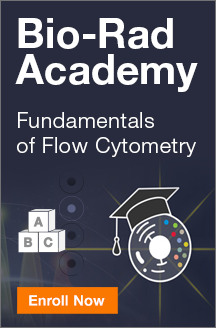-
US | en
- Products
- Applications
- Flow Cytometry
- Flow Cytometry Explained
- Flow Cytometry Basics Guide
- Chapter 7 – Uses of Flow Cytometry
- Innovations in Flow Cytometry

Innovations in Flow Cytometry
Flow cytometry has become more accessible to researchers through a reduction in the complexity of instrument set up, true automation, increased sensitivity and more user friendly software. The increasing number of fluorophores and antibodies available and improved protocols have also made this technique accessible to an increasing number of researchers. Although multicolor flow cytometry using fluorescent markers is still one of the most powerful tools in research, there are some new innovations.
Imaging Flow Cytometry
Imaging flow cytometry allows capture of images of the particles as they pass through the laser using a CCD camera. Multiple (spectrally different) images can be captured simultaneously allowing composites to be made and analysis of antigen location to be determined.
Mass Cytometry
Another innovation is mass cytometry. The introduction of multiple laser containing flow cytometers capable of detecting 27 parameters in addition to forward and side scatter e.g. the ZE5™ from Bio-Rad, has vastly increased the complexity of fluorescent flow cytometry experiments. Mass cytometry however has the capability to detect in 135 channels, allowing multiplex panels to be built and currently over 40 markers can be measured per cell.
Mass cytometry relies on labeling the samples with antibodies bound to metal isotopes which can then be measured by analyzing the time each isotope takes to pass through an electric field towards the detector. The larger the isotope the longer it takes. Sample acquisition is slower with mass cytometry and as the cells are vaporized only analysis can be performed, however there are fewer problems with spillover and compensation. Analysis of the sample can however be time consuming and problematic as it requires specialized software due to the number of parameters that can be collected on one cell.
